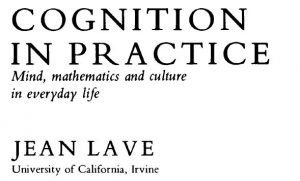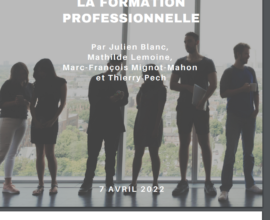Théories et pratique de l’apprentissage situé 33/101

Cognition in Practice (16/n)

Introduction
Dans ce 16e billet consacré au livre de Jean Lave intitulé Cognition in Practice, nous allons résumer la section qui donne les conclusions du chapitre intitulé « Inside the Supermarket (outdoor) and from the Veranda.
Conclusions
L’idée centrale est qu’une même activité, dans différentes situations, est structurée par d’autres activités et est une ressource structurante pour ces autres activités.
« This chapter has presented a series of examples of multiple activities and their mutual shaping in ongoing activity. The central idea is that « the same » activity in different situations derives structuring from, andprovides structuring resources for, other activities. »
Ce point de vue s’oppose de manière spécifique à deux considérations :
– activités et situations sont isolées et sans rapport les unes avec les autres;
– il y aurait des formes de connaissance qui pourraient s’insérer de manière universelle dans toute situation.
« This view specifically opposes assumptions either that activities and settings are isolated and unrelated, or that some forms of knowledge are universally insertable into any situation. Different situations, and indeed different
occasions subjectively experienced as « the same, » are instead viewed here as transformations of structuring resources given a realized form through their mutually constitutive articulation, weighted in different proportions from place to place and time to time. »
L’articulation des ressources ne se fait pas de manière homogène.
à titre d’exemple, l’activité mathématique est plus souvent structurée par, que structurante pour l’action de faire ses courses dans un supermarché.
« The articulation of structuring resources is not likely to vary in an evenhanded way, as if all possible articulations were equally probable. Thus, it seems obvious that math is almost always more structured by, than structuring of, grocery shopping in the supermarket. »
Cela reste une question importante de savoir comment ces articulations se passent … jusqu’à considérer l’implication du système constitutif de l’ordre social au sens le plus large.
Nota: sur ce point l’on pourrait faire un pont avec Pierre Bourdieu « Le sens pratique » (1980)
« But it is still an important question as to how the relatively stable proportional articulations of structuring resources that give practice in the lived-in world its apparently routine and expectable qualities, is constituted. And this question surely implicates the constitutive system of social order in the broadest sense. »
Et de noter que les institutions scolaires réflètent et sont partie d’un ordre constitutif commun.
« We may note very briefly that scholastic institutions reflect and are in part realizations of a common constitutive order. In comparing school curricula and experimental ideologies earlier in the chapter I argued that the proportional emphasis on mathematico-scholastic structuring in these two institutionalized arenas was harmonious, perhaps identical. School and academic psychology clearly affect each other directly but they also share a common history and a common social context as well. An analysis of the specifically cultural and historical character of this web of interrelations is im plicit in the several exam pIes chosen to illustrate the idea of structuring resources and their proportional articulation. «
Une théorie de la pratique considère que l’apprentissage, la pensée et la connaissance sont historiquement et culturellement spécifiques, socialement constitués et politiquement régulés. Ceux-ci structurent le monde social et sont en même temps structurés par lui.
« A theory of practice does take learning, thinking and knowledge to be historically I culturally specific, socially constituted, and politically tempered, and argues that they structure the social world writ large as well as
structured by it. »
Dernier mot
Finalement, Jean Lave, constate que la manière « naturelle », qui-va-de soi, de faire des mathématiques qui imprègne les théories cognitives, l’école et l’idéologie populaire sont plus une explication de ces dernières que de la pratique des mathématiques dans des situations quotidiennes. Et annonce que cela sera approfondi dans les deux chapitres suivants.
« Finally, it should not be too surprising that alumni of schooling – all of us – share the beliefs that shape the social institutions. School alumni respond accordingly as subjects in experimental situations (as chapter 7 will demonstrate further). It follows that taken-for-granted « natural » values about proper math structuring that permeate cognitive theory, schooling and folk ideology are better descriptions of each other than of the practice of arithmetic in everyday settings. But we need not stop there. The next two chapters take up further conceptual develop. »
Billets précédents
Billet 1: Définitions de l’apprentissage situé
Billet 2: Pourquoi s’intéresser à la théorie de l’apprentissage situé?
Billet 3: Démarche et retour aux sources
Billet 4: Mai 1968 et l’apprentissage situé
Billet 5: Apprentissage situé et conversation
Billet 6: Lucy Suchman, mon téléphone portable et moi
Billet 7: Conversations avec moi-même (n° 1)
Billet 8: L’apprentissage situé mis en pratique, cela ferait quoi?
Billet 9: Contribution de la psychologie soviétique à la théorie de l’apprentissage situé
Billet 10: Les apports de la philosophie à la théorie de l’apprentissage situé
Billet 11: Focus sur l’école Dewey
Billet 12: Apports de la psychologie de la perception – la notion d’affordance
Billet 13: Apprentissage situé et intelligence artificielle, deep learning, réalité virtuelle, réalité augmentée, etc…
Billet 14: Conversations avec moi-même (N°2)
Billet 15: Quand John Dewey rencontre Jean Lave
Billet 16: Cognition in Practice (1/n)
Billet 17: Cognition in Practice (2/n)
Billet 18: Cognition in Practice (3/n)
Billet 19: Cognition in Practice (4/n)
Billet 20 : Cognition in Practice (5/n)
Billet 21: « Conversations avec moi même N°3 »
Billet 22: Cognition in Practice (6/n)
Billet 23: Cognition in Practice (7/n)
Billet 24: Cognition in Practice (8/n)
Billet 25: Cognition in Practice (9/n)
Billet 26: Cognition in Practice (10/n)
Billet 27: Cognition in Practice (11/n)
Billet 28: « Conversations avec moi-même N°4 »
Billet 29: Cognition in Practice (12/n)
Billet 30: Cognition in Practice (13/n)
Related Posts
Theories et pratiques de l’apprentissage situé 48/101
Le futur de la formation, selon Terra Nova – La première proposition
Journal d’un WOLer 2/n
Articles récents
Archives
- mai 2024
- mars 2024
- janvier 2024
- décembre 2023
- septembre 2023
- juin 2023
- avril 2023
- mars 2023
- janvier 2023
- octobre 2022
- septembre 2022
- juillet 2022
- mai 2022
- avril 2022
- mars 2022
- février 2022
- janvier 2022
- octobre 2021
- août 2021
- juillet 2021
- mai 2021
- février 2021
- juin 2020
- mai 2020
- avril 2020
- février 2020
- janvier 2020
- décembre 2019
- novembre 2019
- octobre 2019
- septembre 2019
- août 2019
- juillet 2019
- mai 2019
- avril 2019
- mars 2019
- février 2019
- janvier 2019
- décembre 2018
- septembre 2018
- août 2018
- juillet 2018
- juin 2018
- mai 2018
- avril 2018
- mars 2018
- février 2018
- janvier 2018
- décembre 2017
- novembre 2017
- octobre 2017
- septembre 2017
- août 2017
- juin 2017
- mai 2017
- avril 2017
- mars 2017
- février 2017
- janvier 2017
Catégories
- Actualités
- Adaptive Learning
- Allemagne
- Apprendre
- Apprentissage
- Branding
- Business
- Coaching
- Codeveloppement
- Communautés de pratique
- Deep learning
- Design
- Development
- E-Learning
- Ecole
- Education
- Europe
- Formation
- IA
- Intelligence articificielle
- LBC
- metacognition
- Non classé
- Orientation
- orientation
- Philosophie
- Poésie
- Réalité Augmentée
- Réalité Virtuelle
- Transition digitale
- WOL





Commentaires récents